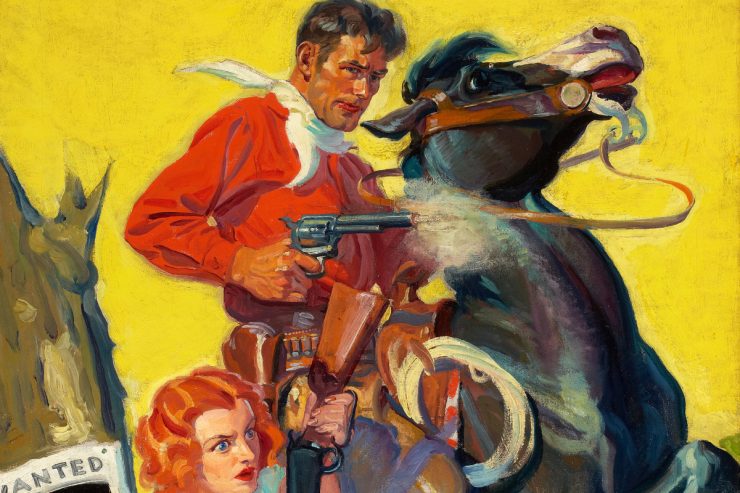 The western story got its start with James Fenimore Cooper’s Leatherstocking Tales, a series of five novels that fictionally adapted the adventures of frontiersman Daniel Boone. In the years following Cooper’s Natty Bumppo stories, authors such as Bret Harte, Francis Parkman, Mark Twain, and later, Owen Wister further expanded the field.
The western story got its start with James Fenimore Cooper’s Leatherstocking Tales, a series of five novels that fictionally adapted the adventures of frontiersman Daniel Boone. In the years following Cooper’s Natty Bumppo stories, authors such as Bret Harte, Francis Parkman, Mark Twain, and later, Owen Wister further expanded the field.
In 1869, when Street & Smith published a fictionalized account of the life of hunter, scout, and showman William F. Cody, it discovered a public hungry for further adventures of the real-life hero of the American frontier. Thus started “. . . the fictionalized form of the Western story . . . based partly on fact, but mostly on imagination.”
Given the great success of Street & Smith’s Buffalo Bill tales, nickel weeklies and dime novels devoted to western heroes and outlaws soon followed. These, as well as stories featuring detective heroes such as Nick Carter and sports heroes such as Frank Merriwell, reigned supreme for nearly forty years. Then, following the introduction of the pulp magazine by Frank A. Munsey in 1896, the story papers and dime novels began to give way to the rough-paper periodicals.
The first all-western pulp magazine was introduced by Street & Smith when they converted their tired old story paper, New Buffalo Bill Weekly, to Western Story Magazine in 1919. Within a year, the magazine had reached a circulation of 300,000 copies and began to be released weekly, a status it enjoyed for the next twenty-five years. Soon thereafter, the magazine began publishing the western fantasies of poet-turned-pulp-writer Frederick Schiller Faust – also known as Max Brand and other pseudonyms – and really took off.
During the early 1920s, Western Story pretty much had the genre to itself. Although westerns were also appearing in general fiction magazines such as Ace-High Magazine, Action Stories, and Adventure, it wasn’t until 1925 that the Street & Smith pulp magazine had any direct competition. It came in the form of Clayton Magazines’ Cowboy Stories and a pair of pulps from John “Bearcat” Glenister’s and Jack Kelly’s Fiction House.
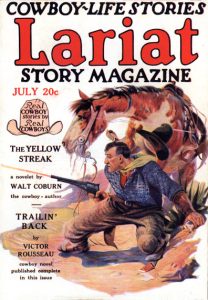 Although introduced separately — North•West Stories debuted in the spring of 1925, while The Lariat Story Magazine was introduced during the summer of the same year — the two magazines were probably meant to be a double-action blast at Western Story Magazine. Both Fiction House pulps featured magazine titles, logos, and slogans that bore more than a striking resemblance to what the Street & Smith titan employed. Of course, persuading Walter J. Coburn to leave the Western Story stable also lends credence to the argument that the two Fiction House titles were meant to tackle the Street & Smith behemoth. The “Cowboy Author” wrote some of his best fiction for these Fiction House pulp magazines.
Although introduced separately — North•West Stories debuted in the spring of 1925, while The Lariat Story Magazine was introduced during the summer of the same year — the two magazines were probably meant to be a double-action blast at Western Story Magazine. Both Fiction House pulps featured magazine titles, logos, and slogans that bore more than a striking resemblance to what the Street & Smith titan employed. Of course, persuading Walter J. Coburn to leave the Western Story stable also lends credence to the argument that the two Fiction House titles were meant to tackle the Street & Smith behemoth. The “Cowboy Author” wrote some of his best fiction for these Fiction House pulp magazines.
Like all Fiction House pulps of the 1920s, North•West and Lariat were looking for action, pure and simple:
Action, stripped to the bone, denuded of all superfluous trimmings spelt with a capital “A” . . . no lengthy descriptions, no long-winded digressions . . . Just the stripped action meat of a dramatic, swift-moving plot . . .
In the mind of Fiction House co-founder John B. “Jack” Kelly, pulp readers craved “. . . the thrill, the action, the aggressiveness of the west.” North•West Stories and Lariat Story Magazine helped fill their readers’ craving for adventure and profited from it.
Perhaps the action-packed — or as editors came to call it, “gun-dummy” — formula that allowed a hero to “kill 50 villains with ten shots,” could have gone on forever. However, it was the advent of The Great Depression in 1929 and the unexpected death of Jack Kelly in 1932 that truly put an end to the Fiction House formula.
At the end of 1932, Fiction House suspended all of its magazines after the attorneys for Jack Kelly’s widow asked that the company to be liquidated to pay her half of the firm’s value. The public, however, was fed a different line . . .
The influx of lower-priced magazines and the financial cheapening of product has created a market which is unsound and cannot continue. . . . Under these conditions, we are best advised to sit on the sidelines until the magazine situation has righted itself.
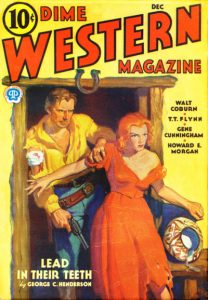 Lending cover to the Fiction House story were two relatively new publishers — Ned Pines’ Standard Magazines and Harry Steeger’s and Harold Goldsmith’s Popular Publications. In late 1931, both publishers introduced the first of their “dime” pulp magazines.
Lending cover to the Fiction House story were two relatively new publishers — Ned Pines’ Standard Magazines and Harry Steeger’s and Harold Goldsmith’s Popular Publications. In late 1931, both publishers introduced the first of their “dime” pulp magazines.
With America in the throes of The Great Depression, these would become the cornerstones for line-ups of similarly priced magazines. Popular even used “Dime” in some of their magazine titles. Both Dime Mystery Book Magazine and Dime Western Magazine debuted at the end of 1932. Dime Adventure Magazine and Dime Sport Magazine would follow a few years later.
Dime Western Magazine, in particular, proved to be an astounding success. With Rogers Terrill — former editor of North•West Stories — at the helm, Dime Western offered readers the same number of pages as Western Story Magazine for a nickel less. Adding former Fiction House stalwarts to his stable of writers — including Walt Coburn, Eugene Cunningham, and Harry F. Olmsted — as well as rustling Cliff Farrell and Ray Nafziger from competing corrals, Terrill was able to offer readers a good deal of action for their dime. And coaxing western yarns out of longtime detective writer, T. T. Flynn, provided Terrill with the type of story that he wanted for the new magazine.
As Popular had done at Dime Detective and would later do with Dime Mystery, Terrill added emotion to the action. Dime Western provided stories that would . . .
. . . put a new tingle into your blood and pull your heart strings. Stark, real-life drama ripped raw from the lives of those sturdy men who lived out their lives on horseback.
The western had become hardboiled.
Beginning at 7:50 PM on Friday, August 5, we hope you’ll join PulpFest 50 as we welcome award-winning popular culture historians Ed Hulse and Will Murray for a look at “The Hardboiled West.” It’s part of our celebration of the centennial of Fiction House and the ninetieth anniversary of Popular Publications’ “Dime” line of pulp magazines.
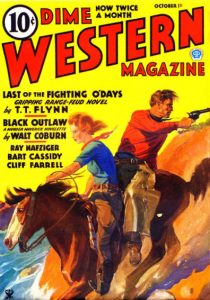 A journalist and pop culture historian, Ed Hulse covered the home video and motion picture industries for more than 30 years. Since 2002, he has edited and published the award-winning, pop culture journal Blood ‘n’ Thunder. The winner of the Lamont Award in 2007, Ed is a prolific public speaker who has lectured on various aspects of vintage American popular culture for museums, libraries, and universities. His books include The Art of Pulp Fiction, The Blood ‘n’ Thunder Guide to Pulp Fiction, Distressed Damsels and Masked Marauders, Handsome Heroes and Vicious Villains, and many other titles. In 2017, he co-edited The Art of the Pulps, with Doug Ellis and the late Robert Weinberg. His most recent books are the Blood ‘n’ Thunder 2022 Special Edition, the horror-pulp anthology Mistress of Death and Desire, and the revised and expanded edition of The Wild West of Fiction and Film. To learn more about Ed Hulse and his work, please visit his website at muraniapress.com.
A journalist and pop culture historian, Ed Hulse covered the home video and motion picture industries for more than 30 years. Since 2002, he has edited and published the award-winning, pop culture journal Blood ‘n’ Thunder. The winner of the Lamont Award in 2007, Ed is a prolific public speaker who has lectured on various aspects of vintage American popular culture for museums, libraries, and universities. His books include The Art of Pulp Fiction, The Blood ‘n’ Thunder Guide to Pulp Fiction, Distressed Damsels and Masked Marauders, Handsome Heroes and Vicious Villains, and many other titles. In 2017, he co-edited The Art of the Pulps, with Doug Ellis and the late Robert Weinberg. His most recent books are the Blood ‘n’ Thunder 2022 Special Edition, the horror-pulp anthology Mistress of Death and Desire, and the revised and expanded edition of The Wild West of Fiction and Film. To learn more about Ed Hulse and his work, please visit his website at muraniapress.com.
Author and essayist Will Murray has written extensively about Lester Dent’s Doc Savage, as well as countless other pulp and pop culture topics. The literary agent for the Lester Dent properties, he has written over twenty adventures of Doc Savage, a solo adventure featuring Pat Savage, three novels about the Popular Publications hero, The Spider, as well as new adventures of King Kong, Sherlock Holmes, and Tarzan. His non-fiction books include Master of Mystery: The Rise of The Shadow, Wordslingers: An Epitaph for the Western, and Writings in Bronze. His most recent book is The Spider: Scourge of the Scorpion. To learn more about Will Murray and his work, please visit his website at adventuresinbronze.com.
The general public is welcome to attend our evening programming events. To learn more about our schedule, please click the Programming button at the top of this page.
To enjoy our dealers’ room, join PulpFest 50 by clicking the Registration button at the top of this page. And don’t forget to book a room at the DoubleTree by Hilton Pittsburgh — Cranberry in Mars, Pennsylvania. They’re going fast!
The work of Stanley L. Wood — an English illustrator noted for his paintings featuring horses in action, often featured with boys’ adventure stories — was used as the cover art for the first issue of Western Story Magazine, dated September 5, 1919. The Street & Smith pulp magazine would last for thirty years and nearly 1300 issues.
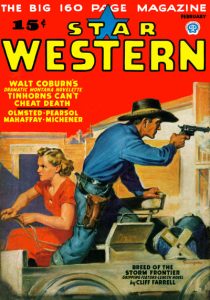 Just as Western Story offered “Big Clean Stories of Outdoor Life,” Lariat Story Magazine featured “Stories of Cowboy Life” and “Real COWBOY Stories by Real COWBOYS.” Pictured above is the July 1926 issue, with cover by George H. Wert.
Just as Western Story offered “Big Clean Stories of Outdoor Life,” Lariat Story Magazine featured “Stories of Cowboy Life” and “Real COWBOY Stories by Real COWBOYS.” Pictured above is the July 1926 issue, with cover by George H. Wert.
Popular Publications’ Dime Western Magazine debuted with its December 1932 issue, right alongside Dime Mystery Book Magazine. It featured front cover art by Walter M. Baumhofer. A freelance artist, Baumhofer painted dozens of covers for Adventure, Big-Book Western Magazine, Detective Tales, Dime Mystery, Dime Western, The Spider, and Star Western. During the 1950s, he created covers and interior illustrations for Popular’s Argosy. He was also a leading cover artist for the Street & Smith chain and other publishers.
With its September 1, 1933 number, Dime Western Magazine began to be published twice each month. It maintained this frequency through its December 1, 1935 issue. Pictured above is Dime Western for October 1, 1934, with another cover by Walter Baumhofer, one of its twice-monthly numbers. Our featured image is also by Baumhofer, illustrating the April 1934 issue of the Popular pulp magazine.
Given the phenomenal success of Popular’s Dime Western Magazine it wasn’t long before Harry Steeger and Harold Goldsmith decided to start another western pulp. Costing a nickel more, but containing thirty more pages, it allowed Popular to feature longer stories. Its first issue was dated October 1933. Both Dime Western and Star Western ran for over 200 issues. Pictured above is Star Western for February 1937, with cover by Norman Saunders.
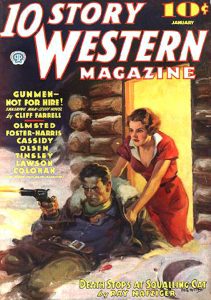 Other successful Popular western pulps included Ace-High Western Stories, Big-Book Western Magazine, Fifteen Western Tales, .44 Western Magazine, Rangeland Romances, and 10 Story Western Magazine. Pictured here is the first number of the latter, dated January 1936 and featuring cover art by Don Hewitt.
Other successful Popular western pulps included Ace-High Western Stories, Big-Book Western Magazine, Fifteen Western Tales, .44 Western Magazine, Rangeland Romances, and 10 Story Western Magazine. Pictured here is the first number of the latter, dated January 1936 and featuring cover art by Don Hewitt.
In 1952, Popular began publishing Western Story Magazine, having purchased the title from Street & Smith. It ran for eleven more issues, giving up the ghost in 1954. The company also published Max Brand’s Western Magazine and Walt Coburn’s Western Magazine, taking full advantage of the popularity of these two western writers.

